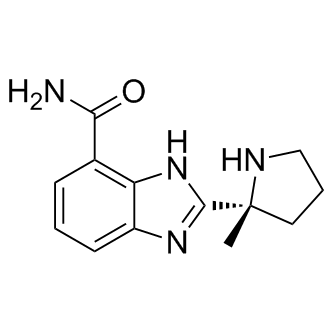| Description: |
ABT888(Veliparib) is a potent PARP inhibitor, inhibiting PARP1 and PARP2 with Kis of 5.2 and 2.9 nM, respectively. |
| Target: |
PARP-2:2.9 nM (Ki)
PARP-1:5.2 nM (Ki) |
| In Vivo: |
Veliparib (ABT-888) is a potent inhibitor of PARP, has good oral bioavailability, can cross the blood-brain barrier, and potentiates temozolomide, platinums, cyclophosphamide, and radiation in syngeneic and xenograft tumor models[1]. In MDA-MB-231 xenograft tumor models, combination treatment (AG014699/Crizotinib and Veliparib (ABT-888)/Foretinib) substantially reduced tumor growth compared to either inhibitor alone[2]. |
| In Vitro: |
Veliparib (ABT-888) is also tested against SIRT2, an enzyme that also uses NAD+ for catalysis, and found to be inactive (>5,000 nM). The receptor profile of Veliparib is determined in a panel of 74 receptor-binding assays at a concentration of 10 μM. Veliparib displaces control-specific binding at 50% or greater at the human H1(61%), the human 5-HT1A (91%), and the human 5-HT7 (84%) sites only. The IC50s for these three receptors are 5.3, 1.5, and 1.2 μM, respectively[1]. c-Met knockdown cells show 4.2- (shMet-A; 95% CI=4-4.5) or 4.6-fold (shMet-B; 95% CI=4.4-4.8) growth inhibition when treated with 60 μM Veliparib (ABT-888). When treated with 38 μM Veliparib, c-Met knockdown cells show 2- (shMet-A; 95% CI=1.5-2.5) or 1.9-fold (shMet-B; 95% CI=1.3-2.5) growth inhibition[2]. In HaCaT cells, at 6 h post-treatment by Veliparib (ABT-888), cell viability is significantly increases under 1,000 µM sulfur mustard (SM) exposure, whereas Veliparib does not protect cell viability under 100 µM SM exposure. Moreover, the addition of Veliparib no longer shows the protective effect at 24 h post SM exposure[3]. |
| Kinase Assay: |
PARP1 enzyme activity is measured by using a commercial assay kit with the exception that cell lysates containing wild-type PARP1 or PARP Y907 mutant are used in place of the PARP1 protein included with the kit. Total lysate (500 ng) is added to each reaction. The dose course of PARP inhibitor Veliparib (ABT-888) is from 0.01 to 1,000 μM. PARP enzyme activity of wild-type and mutants is determined after incubation with the substrate is measured using a plate reader[2]. |
| Cell Assay: |
Cell viability is quantified using the Cell Counting Kit-8 (CCK-8). This assay is based on Dojindo’s highly water-soluble tetrazolium salt. WST-8 is reduced by dehydrogenases in cells to give an orange, water-soluble formazan dye. The amount of the formazan dye generated by dehydrogenases in cells is directly proportional to the number of living cells. Briefly, exponentially growing HaCaT cells are seeded in 96-well plates at a density of 10,000 cells/well. 6 h or 24 h after exposure to sulfur mustard (SM) and the administration of Veliparib, the CCK-8 reagent is added[3. |
| Animal Administration: |
Mice[2] MDA-MB-231 (0.5×106), HCC1937 (2×106) or MCF-7 (5×106) cells are injected into the mammary fat pads of female nude (Swiss Nu/Nu) mice of 6-8 weeks of age. A1034 (0.5×106) cells are injected into the mammary fat pads of female FVB/NJ mice of 6-8 weeks of age. H1993 (0.5×106) cells are injected subcutaneously into the right flank of female nude (Swiss Nu/Nu) mice of 6-8 weeks of age. When the tumor volume reaches 50 mm3, Crizotinib (5 mg/kg) and Foretinib (5 mg/kg), AG014699 (5 mg/kg) and Veliparib (25 mg/kg), dissolved in aqueous 50 mM sodium acetate, pH 4, are administered to mice five times per week as single agents or in combination for the number of days specified in the figure legend. Tumor is measured at the indicated time points, and tumor volume is calculated by the formula: π/6×length×width2. For MDA-MB-231 and A1034 xenograft mouse models, mice are imaged before and after treatment using the IVIS Imaging System to assess tumor growth. Mice are injected with 100 μL of D-luciferin (15 mg/mL in PBS). After 10 min, mice are anesthetized with a mixture of oxygen and isoflurane and imaged using the IVIS Imaging System. Imaging parameters are maintained across experiments for comparative analyses. |
| References: |
[1]. Donawho CK, et al. ABT-888, an orally active poly(ADP-ribose) polymerase inhibitor that potentiates DNA-damaging agents in preclinical tumor models. Clin Cancer Res. 2007 May 1;13(9):2728-37.
[2]. Du Y, et al. Blocking c-Met-mediated PARP1 phosphorylation enhances anti-tumor effects of PARP inhibitors. Nat Med. 2016 Feb;22(2):194-201.
[3]. Liu F, et al. Effects of poly (ADP-ribose) polymerase-1 (PARP-1) inhibition on sulfur mustard-induced cutaneous injuries in vitro and in vivo. PeerJ. 2016 Apr 4;4:e1890. |






















